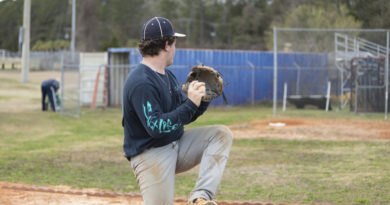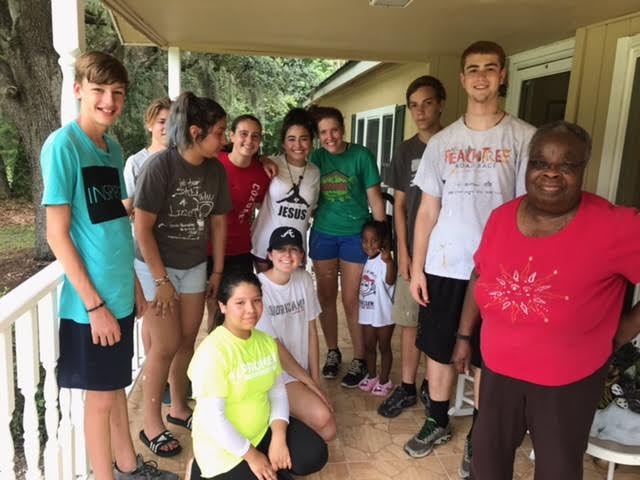Beaufort’s Own Aviatrix
story by mary ellen thompson photography by john wollwerth
On the wall of her study, there is a show-stopping photograph of Pat Denkler from that time in her career when she became the first woman to land a jet on the aircraft carrier. In 1981, she flew a TA-4J aboard the USS Lexington. In the photograph, her expression is confident and accomplished; this was one of those extraordinarily moments where her great courage and beauty intertwined on exactly the same pivot. The following year, she became the first woman to land a fleet combat aircraft, the A6E Intruder on a carrier.
Eager to get to the point of her story, in her very no-nonsense way, Pat breezes through the early years. Her father was a Navy pilot and retired in Pensacola when she was young. After leaving to attend college, she returned to Pensacola to complete her degree in English at the University of West Florida. During this time she met someone who offered to take her flying at a grass air strip; this is when her life changed forever. It was perhaps the biggest of the doors that would continually open up for her, “For the first time in my life, I felt a sense of peace and I knew that I would always fly,” she recalls.
Shortly afterward, Pat became a co-owner of her first plane, a 1946 Aeronca Champ. “I didn’t know anything about the mechanical aspects of an airplane and I wanted to learn. So I moved to Daytona Beach FL, and attended Embry-Riddle to obtain an Airframe and Powerplant license; I kept the Champ at an airport in St. Augustine.
“I had several Navy pilot friends stationed in John McCain’s squadron in Jacksonville and I frequently attended squadron functions.” At one of those events, Commander McCain encouraged her to apply to the Navy Flight Program which had started accepting women in 1973. “He even let me sit in an A-7 where he started the Auxiliary Power Unit so that I could see all of the ‘gee-whiz’ instrumentation!”
Pat applied to Aviation Officer Candidate School and was accepted for the October 1977 class. At that time, approximately fifteen women were selected per year. “Obviously I chose the Navy and left my A&P schooling behind! Most of the women selected for AOCS (think Officer and a Gentleman) were strong athletes, which was most important in the ‘acceptance-factor’ with our male counterparts. In my particular class, there were only two women in the class of twenty-five. In preparation for entering boot camp, I ran three miles in the sand daily to build up extra strength and endurance. I am proud to say that I literally ‘carried my own weight’!”
Although women were first accepted into the Navy Flight Program in 1973, few had become qualified to fly jet aircraft, and none had become qualified to land on a carrier. Pat explains, “There are three pipelines for a pilot to earn their wings: helicopters, propellers, and jets. Women at that time could not get their wings in jets, and could only fly jets after receiving their wings through a jet-transition syllabus, which did not include flying the T-2 Buckeye before flying the TA-4J. Although few women had preceded me in flying jets, their syllabus did not include, among other qualifications, carrier qualifying.” Pat is quick to acknowledge that without the leadership and perseverance of those women, she would not have had the opportunities that were presented to her. “When I flew the TA-4J aboard the carrier, not even the Commanding Officer of the USS Lexington was aware that I was a female! Only after one of my first ‘traps’ did a deck crewman notice my ponytail and, with hand gestures, asked if I was a woman. The Air Boss then asked me if Pat was short for Patrick or Patricia. When I confirmed the latter, he congratulated me and told me to ‘keep up the good work’. A personal commendatory letter followed.
“Subsequently,” Pat says, “when I met the Chief of Naval Air Training, I asked if I could talk with him pilot to pilot and not Lieutenant JG to Admiral. When he responded in the affirmative, I proceeded to describe the abbreviated jet transition syllabus I received and that the training did not include the T-2 Buckeye normally used to introduce pilots to jet aviation. As a result, Admiral Martin became very influential in making the decision to allow women to earn their wings through the jet pipeline, thus allowing them to train exactly as their male counterparts.”
Pat’s final assignment of active duty was when she flew the EA-6A, which, she explains is “a specially configured aircraft to provide a realistic electronic warfare environment for fleet exercises. Among many of the roles was simulating a ‘missile profile’ so that a carrier could assess its detection capabilities.”
“Flying taildraggers and open cockpit aircraft was my heartbeat, but the single best professional decision I ever made was joining the Navy. There are absolutely no words to describe the camaraderie and the patriotic feelings associated with serving one’s country!”
After leaving active duty, Pat joined a reserve squadron in Norfolk VA, with the intent of applying to the College of William and Mary to study international relations. But again her plans to continue her education took a sharp turn in a different direction. Many of her friends were airline pilots and encouraged her to consider doing the same. Another door was about to open; she applied to and was accepted by Delta Air Lines, with whom she has flown for over three decades.
“I have been with the airline for 31 years; as a 767ER international captain I am senior enough to be able to choose the three to four international trips I fly each month. I love flying internationally. It’s been a great job and there is so much to be grateful for!
“Working for the airline was the second best decision I ever made. It has allowed me to live two lives; when you’re not at work, you’re not at work. Because I could live anywhere I want to live, I came to Beaufort in 1988. Among other things, what this place has really given me is a chance to be a viable part of the community.”
Pat’s involvement with local organizations is legendary and the list is lengthy. Some of those closest to her heart are the AMIkids Beaufort, Beaufort County Open Land Trust, USCB Center for the Arts, Pat Conroy at 70, and the Pat Conroy Literary Center.
“I’ve made my choices because I believe that when a door opens, go through it – see what’s on the other side. There will be no more repeating anything I’ve already done. I’ve recently sold my J3 Piper Cub to a great guy. Obviously it was a bittersweet decision because I’ve had several different aircraft over the past forty years. My husband, Mike Harris, and I recently bought a sailboat and we are learning to sail; we are as happy as five year olds playing while we are learning. The sea is my new sky.”
When not flying either the skies or seas, Pat loves being a homebody and it’s easy to see that her home is her oasis. Mike’s hobby is photography and his striking photographs line the hallway, all taken in black and white with old German cameras. “I love my home, my collections, and my antique furniture which is mostly pre-civil war except for the upholstered pieces.”
For a woman who has traveled the globe, set records, and has so many fearless achievements to her credit, it’s the little things that are near to her heart. With a gentle touch, Pat gets up in the morning and cuts fresh flowers for every room in the house. Then she works at her desk until about noon when she ventures out into the bigger world. “Home is real important to me. As are my books, I love my books! Some of my lifetime favorites are The Little Prince, Gift From the Sea, The Fountainhead, and For Those I Loved. I also journal, and have since I was eight; I only write with real pencils.” She laughs as she confides, “I found one I like and bought a hundred like it. I use them to make all my own greeting cards,” she says with obvious enjoyment.
Pat Denkler is one of those rare people who knows exactly who she is, and fully understands what is important to her. Those people and organizations with whom she is involved, are very blessed.




